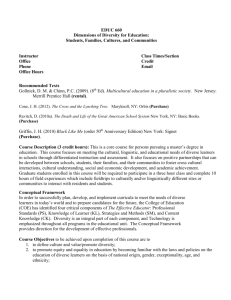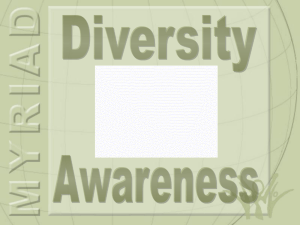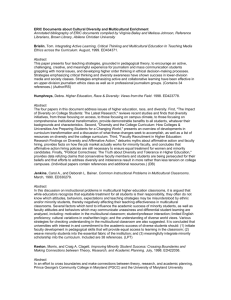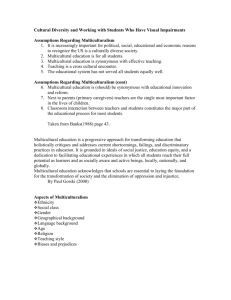630_diverse - Vance Cameron Holmes
advertisement
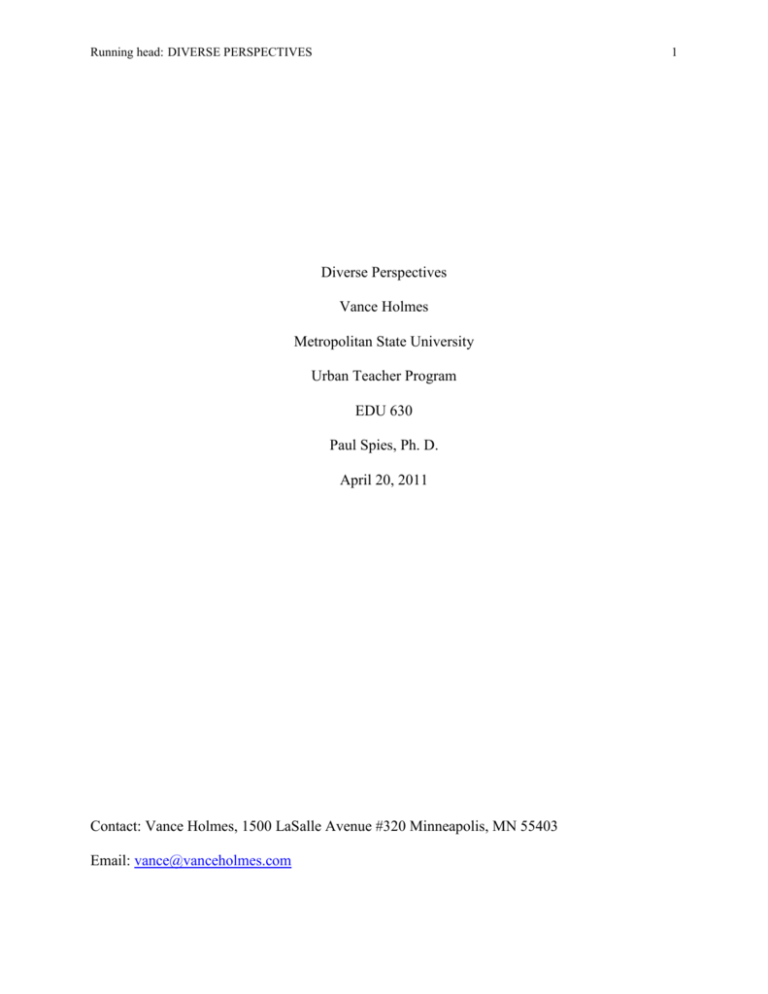
Running head: DIVERSE PERSPECTIVES 1 Diverse Perspectives Vance Holmes Metropolitan State University Urban Teacher Program EDU 630 Paul Spies, Ph. D. April 20, 2011 Contact: Vance Holmes, 1500 LaSalle Avenue #320 Minneapolis, MN 55403 Email: vance@vanceholmes.com DIVERSE PERSPECTIVES 2 Diverse Perspectives Just as urban educators must consider such factors as personal disposition and family background on student learning, teachers must consider and plan for the impact of culture. There is no question about it. James Banks, one of the pioneers of multicultural education, concluded that it is necessary for teachers to “understand the complex characteristics of ethnic groups within U.S. society and the ways in which race, ethnicity, language, and social class interact to influence student behavior” (Banks, 2001). The phrase, culturally relevant teaching, was created by Gloria Ladson-Billings to describe “a pedagogy that empowers students intellectually, socially, emotionally, and politically by using cultural referents to impart knowledge, skills, and attitudes” (Ladson-Billings, 1994). Decades of research by hundreds of scholars has firmly established that a culturally responsive classroom will improve students' educational experiences and increase achievement. There are some education professionals however, who have expressed concerns about culturally responsive – culturally differentiated – instructional strategies (Jacob, 2010). They fear the practical implications of the multicultural education model may lead to instructional planning based on the very ethnic stereotyping and prejudice it aims to eliminate. Cultural communities are not monolithic, they reason, so research into cultural norms and broad patterns of beliefs and behaviors is not an appropriate component of instructional design because each student is a unique individual. Two Sides to Every Story It is critically important for urban educators to approach this argument with clarity about what the term “culture” means in the context of multicultural education. Culture does not here DIVERSE PERSPECTIVES 3 refer to static categories of populations broken down by race, ethnicity and religion as often used in historic, demographic and sociological study. As it concerns the classroom, culture is understood to be the ever-changing, interconnected set of artifacts, symbols and conceptual representations made manifest by the ideation and experiences of people and groups. Multiculturalism then, is an explicit recognition of the underlying reality that each individual finds identity through a dynamic weaving of multiple cultural influences. Each one of us is multicultural. That is to say, a student might identify as a female, and a Protestant, and an African American and so forth – maintaining varying levels of identification with dozens of other communities and social groups. Common Sense Culture and cultural influences, in an educational context, are in no way restricted to predefined “racial” lines and demographic boundaries (Jacob, 2010). The multicultural perspective is anchored in the concept that the cultivating and communicating of diverse cultural knowledges – different ways of abstracting the world – will be beneficial for all, as we all may learn from each other’s experience and wisdom. Focused on examining and exploring arbitrary social classifications and stereotyping, we are empowered to respond. We are strengthened through the continued re-cognition of our diversity as multicultural communities and multicultural individuals. In the cooperative learning environment of the multicultural model, we find verification of our truths in others’ truths. We arrive at cross-cultural commonalities and common sense, and through that process, falsehoods naturally become apparent. So it stands to reason that any instructional tactic found to be an effective teaching strategy for one particular group of learners – will be effective for all learners. If it proves only to have some effect on DIVERSE PERSPECTIVES 4 students of a certain religion or a select economic status, then the tactic is suspect, since quality instruction has no church or bank affiliation. Good Instruction gets good results. Begging to Differ While we may be moving toward a post-racial society – culture will always be with us. It will remain a critical consideration for the urban educator in curriculum design, instructional planning and classroom management. Culture is the engine of cognition. It is central to every aspect of education – and therefore, a culturally relevant classroom is central to narrowing our nation’s achievement gap (or as Gloria Ladson-Billings more precisely termed it, our “education debt.”) Through cultural expressions, ideation and symbolic representations – culture dictates how human beings think and behave (Jacob, 2010). Multicultural education is not a pop psychology fad that will eventually fall to the side. Nor will it be pushed aside based on fears that open, frank discussions and strategies concerning cultural diversity will somehow deteriorate into racism and stereotyping. Culturally relevant instructional design is a reflective, responsive teaching model that demands self-assessment, cultural sensitivity and cultural competence. Knowing Better Time and testing has settled the debate about acknowledging the component of culture in the classroom. Half a century of solid research reveals that – while various aspects may make us uncomfortable from time to time – the multicultural education model and its associated processes are central to maximizing individual and group learning opportunities in the diverse urban classroom. In A Framework for Culturally Responsive Teaching, Raymond Wlodkowski reported “research has shown that no one teaching strategy will consistently engage all learners. The key is helping students relate lesson content to their own backgrounds” (Wlodkowski, 1995). Christine Bennett outlined a conceptual framework for multicultural teaching (Bennett, 2001). DIVERSE PERSPECTIVES 5 Her protocol includes: curriculum reform, teaching toward social justice, multicultural competence and equity pedagogy. According to Abt-Perkins and Rosen, having a culturally responsive teaching knowledge base enables urban educators to create "collaborative and culturally sensitive classroom environments, cultural patterns in classroom verbal interactions, and other cultural dimensions of reciprocal interaction and dialogic instruction" that encourage "the participation and engagement of the diverse students in their classrooms" (Abt-Perkins and Rosen, 2000). At the heart of multicultural education is culturally relevant teaching which serves to support the instructional needs of all learners – regardless of their cultural background or ethnic heritage. Lisa Delpit clarifies and succinctly summarizes the multicultural classroom instructor’s mission: "The question is not necessarily how to create the perfect 'culturally matched' learning situation for each ethnic group, but rather how to recognize when there is a problem for a particular child and how to seek its cause in the most broadly conceived fashion" (Delpit, 1995). DIVERSE PERSPECTIVES 6 References Abt-Perkins, D., & L. Rosen. (2000). Preparing English teachers to teach diverse student populations: Beliefs, challenges, proposals for change. English Education, 32(4), 251–66. Banks, J., Cookson, P., Gay, G., Hawley, W., Irvine, J. J., Nieto, S., Schofield, J. W.,& Stephan, W. G. (2001). Diversity within unity: essential principles for teaching and learning in a multicultural society. Phi Delta Kappan, 83(3), 196-203. Bennett, C. I. (2001). Genres of Research on multicultural education. Review of Education Research, 71(2), 171-217. Delpit, L. (1995). Other people’s children. Cultural conflict in the classroom. New York: The New Press. Jacob, E. (2010). Cultural inquiry process. Retrieved April 1, 2011, from http://classweb.gmu.edu. Ladson-Billings, G. (1994). The Dreamkeepers: Successful teaching for African-American students. San Francisco: Jossey-Bass. Wlodkowski, R. & Ginsberg, M. (1995). A framework for culturally responsive teaching. Educational Leadership, September, 17-21.

